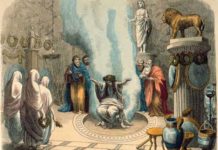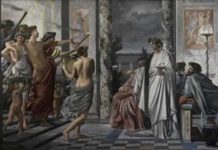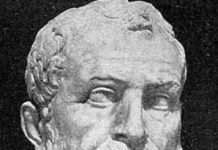Ancient Greek military history is inextricably bound up with homosexuality. In some ancient Greek city states, such as Sparta, each young warrior had to take a lover and mentor from among the seasoned fighters as part of his military training. In other city states, such as Thebes and Athens, such arrangements were common on a more informal basis. For the close hand-to-hand fighting of the Greek hoplites, which relied on each man defending his partner, intimate bonds guaranteed each warrior would fight to the death before abandoning his post. Nowhere was this theory taken to greater extremes than in the Sacred Band of Thebes.
Greek hoplites in Ancient Greek military history
Hoplites were the elite warriors of the Greek fighting world. Each was armed with a short sword, a spear and a small round shield. They fought in a phalanx formation with the shield on their left arm protecting the warrior to their left, and receiving the same protection from the warrior on their right. Hoplites would march in formation against lines of enemy hoplites and push up against them, jabbing with their spears.
When the signal, or othismos was given out, the hoplite phalanx would advance the decreed number of steps forward. The enemy line would either hold or break. A breaking phalanx would then flee or be chased from the field by light cavalry.
Battles were short and rarely lasted more than an hour. The winning phalanx was usually that with the highest discipline and courage; known in Greek as dynamis – the will or ability to fight. It was in the Theban Sacred Band that this dynamic will to fight found its highest expression.
Homosexual fighting units – the Sacred Band of Thebes
The Sacred Band was formed by the Theban commander Gorgidas in 378 BC. It consisted of 150 warriors and their younger warrior lovers, and was the elite force of the Theban army for over 40 years. Under the command of the general Pelopidas, they routed a Spartan force three times their size at Tegyra in 375 BC. They also fought at the famous battle of Leuctra in 371, whereby the Thebans gained their independence from Sparta. They were seen as contributing significantly to the military and political eminence of Thebes throughout their existence.
According to Plutarch, the inspiration for the unit is thought to come from Plato’s Symposium, wherein the character Phaedrus remarks,
“A band which is united with ties of love is truly indissoluble and unbreakable, since both lovers and beloved are ashamed to be disgraced in the presence of the other, and each stands his ground at a moment of danger to protect the other.”
The end of the first known gay fighting unit
The Sacred Band was undefeated for the entire forty years of its history, until its final annihilation by Philip of Macedon and his son Alexander (another world famous gay soldier) at the battle of Chaeronea in 338 BC. Overwhelmed and surrounded by the Macedonians, and at the mercy of their superior weaponry, the Sacred Band refused to surrender. They held their ground and nearly all the 300 perished on the spot along with their last commander, Theagenes.
In about 300 BC the Thebans erected a giant marble lion on a stone pedestal at the burial site of the Sacred Band, known as the Lion of Chaeronea. It was restored by English travellers last century and can be visited today. In 1890 the burial site was excavated and revealed 254 skeletons, neatly arranged in seven rows.








